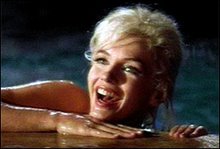
As team lead of Project SCOBY Doo™, I prefer to “keep it organic” on a certain level and follow the example of Special Agent Cooper. Sometimes when all of the random events culminate into something incredibly far fetched, we might need to throw darts, participate in other random events or simply step back for a moment and contemplate a donut or a duck. While Casey’s Tahoe trip seems to confirm our plankton theories, Stephanie J’s reference to ducks on EN has sent us in many different directions. There must be a connection, but we’re still piecing it together.
For those too young or uninterested in David Lynch here’s a Twin Peaks thematic synopsis brought to you by Wikipedia:
Themes
As with much of Lynch's other work (notably Blue Velvet), Twin Peaks explores the gulf between the veneer of small-town respectability and the seedier layers of life beneath it. Each character from the town leads a double life. The show further resembles Lynch's previous and subsequent work in that it is difficult to place in a defined genre: stylistically, the program borrows the unsettling tone and supernatural premises of horror films, and simultaneously offers a bizarrely comical parody of American soap operas with a campy, melodramatic presentation of the morally dubious activities of its characters. Finally, like the rest of Lynch's oeuvre, the show represents an earnest moral inquiry distinguished by both weird comedy and a deep vein of surrealism.
A popular feature of the series was Frost and Lynch's use of repeating and sometimes mysterious motifs — trees, water, coffee, donuts, owls, ducks, fire — and numerous embedded references to other films and TV shows, such as The Twilight Zone (mysteriously malfunctioning electrical equipment), and The Patty Duke Show (the phenomenon of identical cousins).
Currently we’re participating in a brief TM & tea break.
For those too young or uninterested in David Lynch here’s a Twin Peaks thematic synopsis brought to you by Wikipedia:
Themes
As with much of Lynch's other work (notably Blue Velvet), Twin Peaks explores the gulf between the veneer of small-town respectability and the seedier layers of life beneath it. Each character from the town leads a double life. The show further resembles Lynch's previous and subsequent work in that it is difficult to place in a defined genre: stylistically, the program borrows the unsettling tone and supernatural premises of horror films, and simultaneously offers a bizarrely comical parody of American soap operas with a campy, melodramatic presentation of the morally dubious activities of its characters. Finally, like the rest of Lynch's oeuvre, the show represents an earnest moral inquiry distinguished by both weird comedy and a deep vein of surrealism.
A popular feature of the series was Frost and Lynch's use of repeating and sometimes mysterious motifs — trees, water, coffee, donuts, owls, ducks, fire — and numerous embedded references to other films and TV shows, such as The Twilight Zone (mysteriously malfunctioning electrical equipment), and The Patty Duke Show (the phenomenon of identical cousins).
Currently we’re participating in a brief TM & tea break.
BTW, the BUNDLE-WRAPPER Donald duck below is brought to us by a sweeeeeet blog: http://paleo-future.blogspot.com/










4 comments:
Murst!
And I like earnest moral inquiry.
Obviously ducks have NOTHING to do with Casey's Tahoe vacation. Stick with the plankton theory.
hello?
The ducks ate his website!!!
Post a Comment